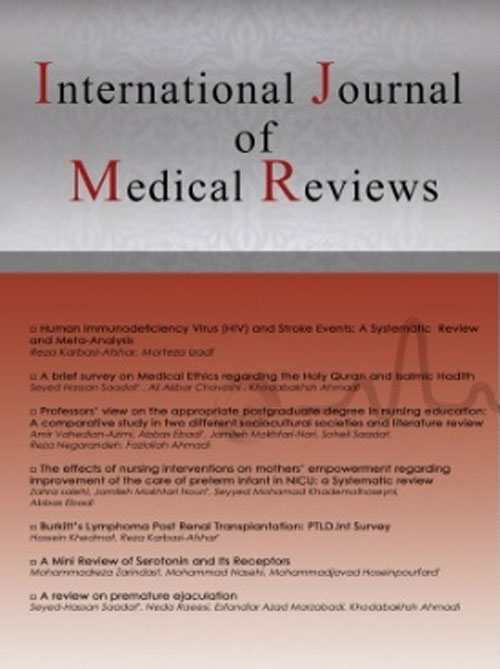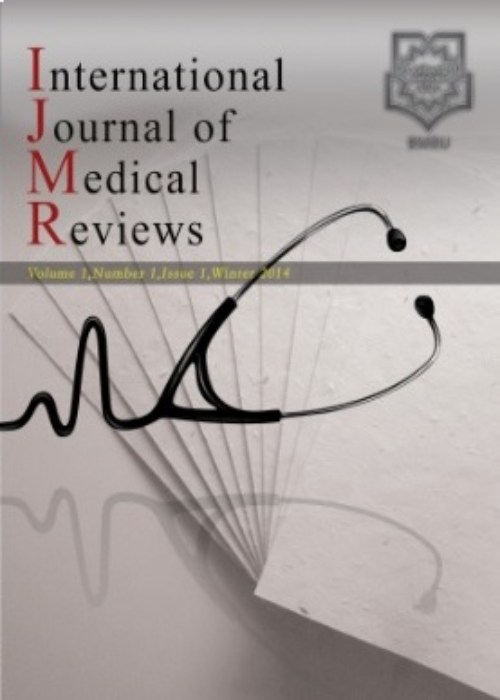فهرست مطالب

International Journal of Medical Reviews
Volume:2 Issue: 2, Spring 2015
- تاریخ انتشار: 1394/05/03
- تعداد عناوین: 7
-
Page 230IntroductionHuman everyday life is full of stress and strain, so that the present century is called stress era. Unfortunately, here is no literature integration about stress. The aim of the present paper is to make a theoretical integrative consensus in stress modalities.MethodsThe design of the present study was systematic review. Inclusion criteria were subjective relevance to study keywords (include stress, stress control, stress reduction, social stress, community stress, group stress, stress increase, stress side effects, stress resources, stress stages, stress types), being published by academic and/or scientific resource, and publication period (between January, 1, 1990 and March, 20, 2015). Using Jadad scale, those clinical trial papers with 2 and upper were selected. Delphi method used to form the structure of final results. Results were collected by content analysis.ResultsEleven major definitions, three main classifications, three fundamental explanatory perspectives, occupational stress and related issues, job burnout and related issues, biological and neuropsychological bases, related constructs (anxiety, homeostasis, allostasis), spiritual/religious/Islamic perspectives, stress outcomes, and multiple relations between stress and culture were presented and discussed.ConclusionThe ppresent study was an effort to make a theoretical unity of thought in studies about stress. According to the results, it appears that stress cannot be investigated via unimodal studies, and there is a great need to incorporate BioPsychoSocioSpiritual perspective in analyses and future frameworks of stress studies.Keywords: Stress, Hypothalamus, Pituitary, Adrenal (HPA) axis, Homeostasis, Allostasis, Cultural stress, BioPsychoSocioSpiritual model, Systematic Review, Jadad Method, Delphi Method
-
Page 238Chronic obstructive pulmonary disease (COPD) is one of the few major causes of death whose prevalence is continuing to rise in the world. Pulmonary rehabilitation (PR), as a component of the treatment protocol, should be considered for all patients with chronic respiratory disease who have persistent symptoms. The purpose of the study was to investigate PR in patients with COPD, following six questions including comprehensive definition, nature's mechanism, commencing indication, advantages and disadvantages, comprehensive dimensions, and the cornerstone dimension of PR. The University of York Center for Reviewers and Dissemination Guidance approach was used for searching seven databases (Science Direct, Ovid, Cochrane, Ebsco Host, Scopus, Pub Med, and SID) with nineteen keywords and different combinations of aforesaid nineteen keywords from the year 1985 to the January 2015. Thirty full texts met the inclusion criteria and were analyzed for responding to the six research questions. The results showed that PR consists of exercise training, education, nutritional intervention, support in self-management behaviors, and psychosocial support. The extensive review of the literature indicated exercise training is the cornerstone of PR, but the study also corroborated that psychological aspect of the patients with COPD is the most important and the first dimension in PR. Furthermore, before the commencing any education, the patients with COPD in any stages, must have an effective and useful psychological support for ameliorating and improving the applicability of the PR.Keywords: Pulmonary rehabilitation, Chronic Obstructive Pulmonary Disease, Exploratory Review
-
Page 250IntroductionFamilies of patients with schizophrenia face serious challenges due to clinical heterogeneity and multiplicity of symptoms and their management. Investigating educational needs of families can improve the quality of life for both patients and families. In this study, special educational needs of these families were investigated through a systematic review of previous studies.MethodsThis systematic review was conducted in Persian data bases such as Iranmedex, Iran doc, SID and English data bases of Cochran, PubMed, Science Direct, and Medline. Also, the used English keywords were educational needs, family, schizophrenia and their equivalents in Persian language. A total of 15740 articles were found. Finally by considering the inclusion criteria, 16 articles were selected and evaluated to answer the study’s questions.ResultsThe analysis of the data extracted from the 16 selected papers for the research question implies that the needs of families of patients with schizophrenia include six dimensions: social interactions, support resources, access to the unknown items in the disease, coping and stress management, stigma and improving the quality of life.ConclusionThe results suggest that proper understanding of the problems in families of patients with schizophrenia not only helps the families of patients, but also teaches the professionals involved with them to change their attitude towards educational planning. Furthermore, any planning without considering the role of family is doomed to fail.Keywords: Educational Needs, Family, Schizophrenia
-
Page 256IntroductionNutritional support is an essential component in the intensive care unit. ICU patients than other patients are susceptible to malnutrition, because of the severity and complexity of their care. The aim of this review was to determine the impact of implementing nutrition support on patient outcomes in intensive care unit (ICU).MethodsArticles include conferences, seminars and published articles in international journals by using standard and sensitive keywords such as nutrition support, intensive care unit and patient outcomes were reviewed. The articles published in journals, databases (Science direct, PubMed, cochrane library, oxford, google Scholar, springer, Highwire, Ovid, Wiley, thieme, BMJ clinical evidence, MD consult, up to date) between the years 2003 - 2013 which included the quality control criteria for entry into systematic review. Then the articles which included the Inclusion criteria for entry into the study was selected and after the quality control were entered to a systematic review process.ResultsFrom 1470 retrieved articles, seven articles were analyzed. However, Nutritional support has the positive effect on the delivery of nutrients to critically ill patients; but regarding the studies, different nutrition support algorithms will have a variety of consequences (hospital mortality, length of ventilation, ICU length of stay, and hospital length of stay) in various communities.ConclusionUsing a programmed nutrition protocol based on evidence uses safe methods according to patient's needs and in appropriate time will provide better results while it will be accompanied with exact evaluation of nutrition status and improvement indicators.Keywords: Nutrition Support, Intensive Care Unit, Patient Outcome, Critical Care Unit
-
Page 261In recent years, the association between social factors and individual's health status has been paid special attention to by health system researchers and policy makers. According to the WHO conceptual framework of Social Determinants of Health (SDH), lifestyle is one of the intermediary factors affecting the individual's health and disease and is related to their individual, social and spiritual dimensions. Many of the health complications associated with lifestyle can be prevented or delayed using strategies for health promotion and prevention of disease. Preventing diseases affected by lifestyle and promoting physical and mental health requires knowledge of how life situations endanger people's health. Efforts made to improve health by enabling people to change their lifestyles should be in line with both the individual changes and social and living conditions changes which are effective in lifestyle. This review study has aimed to identify the dimensions of lifestyle, as one of the social determinants affecting health, and their role in the health and disease outcomes of the military personnel according to the World Health Organization framework.Keywords: Prevention, Lifestyle, Social Determinants of Health, Military Personnel
-
Page 273Disaster as an undeniable part of human life, is followed by some adverse economic effects. All equipments and facilities available in the society need to be mobilized according to their responsibilities and restrictions in the form of crisis management in order to combat it and to minimize the effects of crisis. Moreover, a systematic approach to the design, implementation, monitoring, evaluating the specific services, and providing the basic needs, good coverage, improved access and the high quality of service is desirable. It is obvious that Iran is not excluded from this rule, and like other countries, is an accident-prone country and can be considered as one of the most vulnerable countries to disaster. Evaluation of health care during natural disasters in Iran indicates the lack of coordination in providing health services. A comprehensive coordination is considered as the core activity before and during crisis. Therefore, the present review has aimed to study the coordination among organizations involved in the crisis, and the operational issues and solutions for effective and efficient responses, through search in valid Databases using some keyword such as Coordination in disaster, Coordination concept، Coordination barriers، Coordination facilitators، coordination in response، issue of coordination. Papers between 1995 and 2015 were searched and studied. It is not simple to coordinate among the responsible and service provider organizations and institutions, requiring a systematic approach in all actions and also inserting the coordination issue as a strategy in the comprehensive plan of crisis management. In order to reduce the adverse effects of crisis, in addition to apply a comprehensive plan in the crisis response phase, the coordination among the organizations should be promoted using some measures in the pre-crisis phase (preparation).Keywords: Coordination, Disaster, Narrative Review
-
Page 282IntroductionIn recent decades, increasingly crowded emergency departments (ED) cause considerable burden on the world's health care systems. Among the reasons for this bustle is the lengthy stay of patientsMethodIn this study, a systematic review was used, and the required information, with the purpose of focusing on the research question, was retrieved, evaluated, and integrated.ResultsThe results of analyzing the data of 11 selected papers with the inclusion criteria and keywords specified from 2007 to 2014 in line with the research question suggests that there are various methods to reduce the Emergency Department Length Of Stay (EDLOS) of patients which are summarized in several classes.Equipping and improving of existing facilities in emergency departments, such as triage, observation units, operating and testing rooms, and advanced imaging needed by patients as well as modifying caring processes and adequate staffing are listed as the most important factors affecting the reduced length of stay.ConclusionImproving existing structures in the emergency department, facilitating the processes of care, and providing adequate staffing are among the factors that significantly cause the reduced EDLOS. The reduced EDLOS, as a result, causes overcrowding to be reduced, the capacity to accept new patients as well as patient and nurses satisfaction to be increased, and also the quality of medical care to be improved.Keywords: Emergency Department, Length of Hospital Stay, Nurse, Iran


